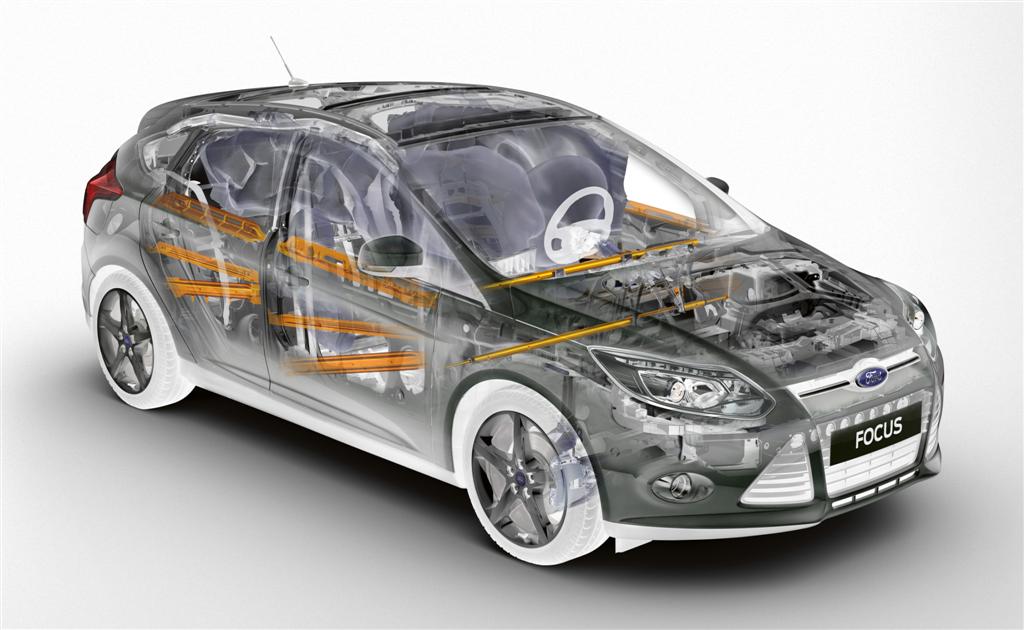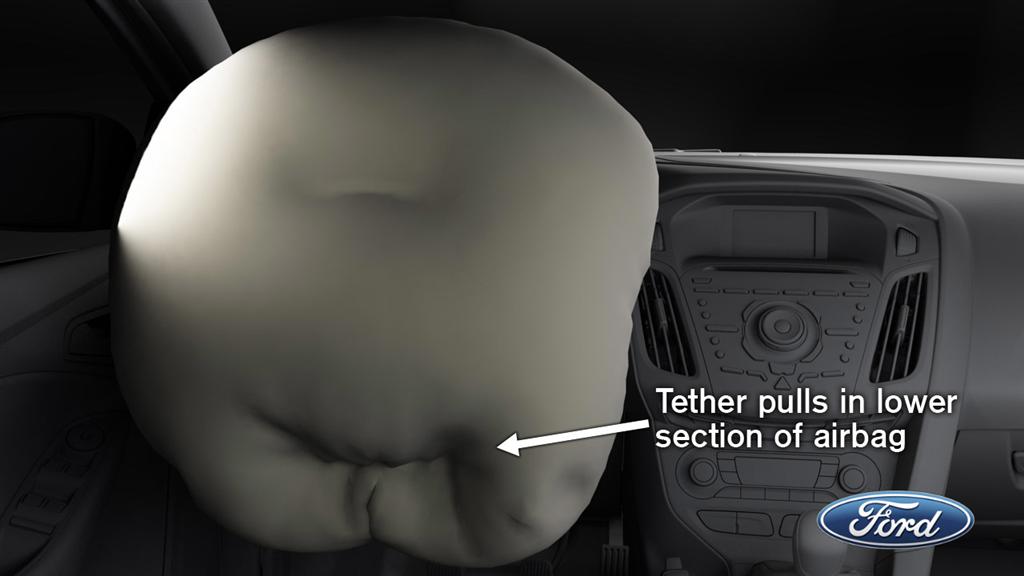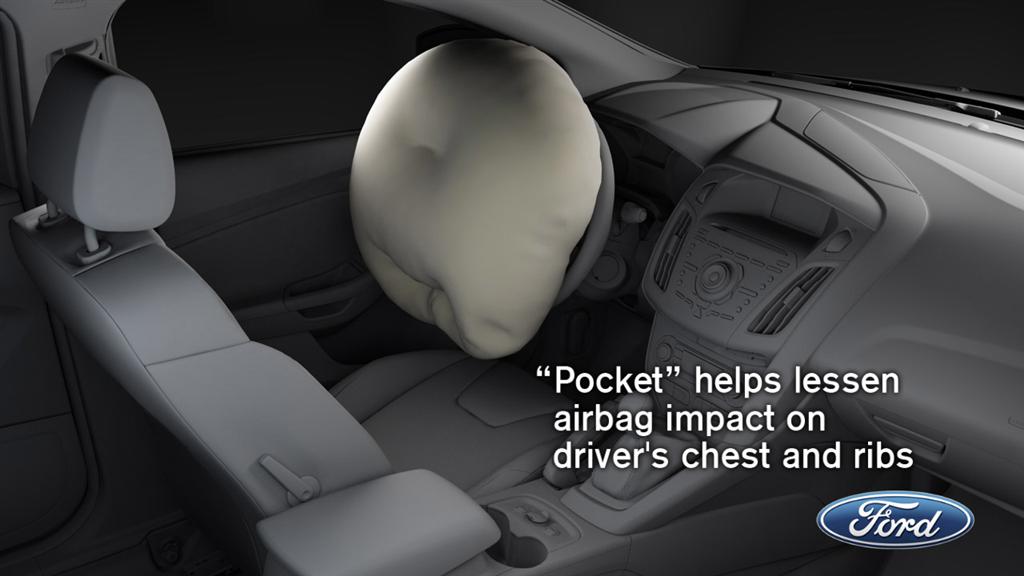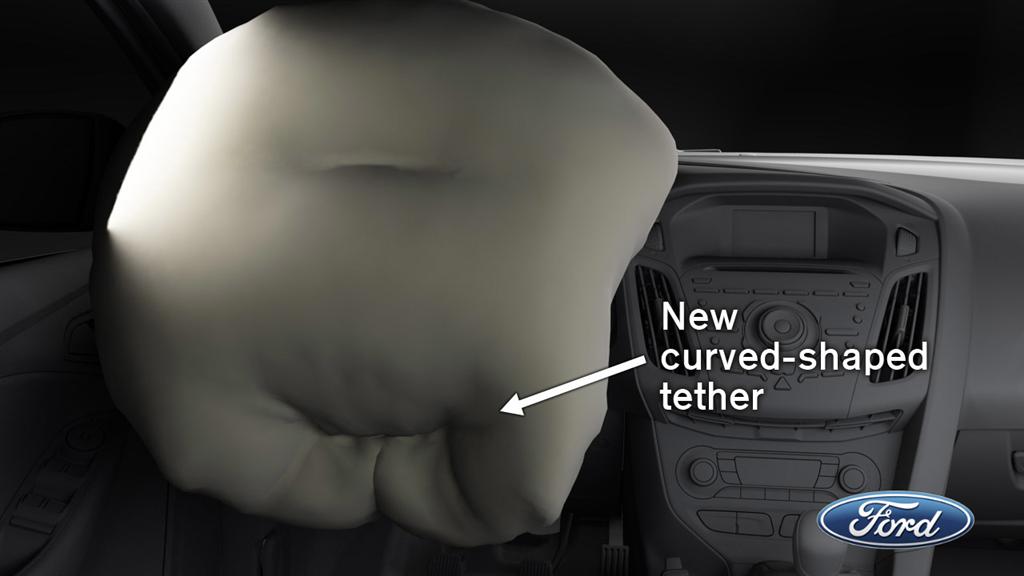|

01-06-2011, 06:10 PM
|
 |
Chairman & Administrator
|
|
|
|
 All-New Ford Focus Body Structure Is Lighter, Stronger And Safer
All-New Ford Focus Body Structure Is Lighter, Stronger And Safer
MELBOURNE, Australia, 01 June, 2011
** All-new Focus is engineered to exceed global safety standards
** More advanced high-strength steel than any previous Ford – over 55 per cent of the structure is made from high-strength and ultra high-strength steels
** Unique ‘tailor rolled’ B-pillar design with varied thickness for optimum strength
The all-new Ford Focus has an exceptionally strong, stiff and light steel body shell, which has been engineered to exceed global safety standards.
The body structure, which has been rigorously optimised using state-of-the-art computer simulation tools, makes use of advanced high-strength steels and innovative fabrication technique to minimise body weight while delivering enhanced crash performance, improved vehicle dynamics and superior refinement.
“The new Focus uses more high-strength steels than any previous Ford,” said Helmut Reder, Focus Chief Programme Engineer.
“These advanced materials help us cut fuel consumption by reducing weight, while still improving the strength and stiffness we need for vehicle safety and dynamics.
“Innovations like the ‘tailor rolled’ B-pillar design have enabled us to raise the strength and efficiency of the structure to a new level.”
High-strength steels enhance structural performance
Advanced high-strength steels are used extensively in the next-generation Focus body shell.
High-strength steels comprise more than 55 per cent of the body shell, and more than 26 per cent of the vehicle’s structure is formed from ultra high-strength and Boron steels – significantly more than any other Ford product.
On average, the yield strength of the steel in the body is 47 per cent higher than the current generation Focus. The structural integrity of the body shell is also reflected in its torsional rigidity: the new five-door Focus hatch is 15 per cent stiffer than the current model.
To further enhance dynamics and refinement, engineers put special attention on increasing the local stiffness of the structure at the suspension mounting points. In these areas, the body stiffness has increased by as much as 75 per cent.

Innovative B-pillar design increases strength, cuts weight
The advanced design of the Focus body structure can be illustrated by the B-pillar reinforcement, a key structural part which is made from ultra high-strength Boron steel that has been produced using an innovative ‘tailor rolling’ process.
The process allows the thickness of the steel sheet to be varied along its length, so that the part has increased strength in the areas that are subjected to the greatest loads.
The tailor rolled B-pillar in the all-new Focus has eight different gauges, ranging from 1.35 mm to 2.7 mm, and in addition to optimising side impact crash performance, the new design saves 1.4 kg in weight per vehicle.
Optimised safety structure
Other key design features on the Focus body structure include:
** Ultra high-strength Boron steel used in the A-pillars, B-pillars, rocker panels and door reinforcement beams to create an extremely rigid passenger cell that minimises deformation in a crash – including side, side pole and roof crush impacts
** Integrated door opening reinforcement ring and door load paths produced from high-strength steel to resist side intrusion and maintain structural integrity
** High-strength steel front crash structure to efficiently manage high crash forces and maintain good crush behaviour, transferring loads in a controlled way to the body side structure via three load paths in the A-pillar, the rockers and the door waist rails
** Very high-strength dual-phase steel used in front crash structure, inner rocker panels and floor cross members for maximum crash energy absorption, and to maintain integrity of the passenger cell
** Front chassis sub-frame that is designed to de-couple from the lower body attachment point during a frontal crash event. By reducing the loading, this patented de-coupling system avoids deformation in the passenger cell foot-well area.
All-New Ford Focus Safety Systems Meet Toughest Global Standards
** Expanded safety testing for the all-new Focus, including more than 12,000 virtual and real-world crash tests globally
** Enhanced Ford Intelligent Protection System in the all-new Focus engineered to exceed global safety standards
** Body structure and restraint systems subjected to comprehensive testing to prove new safety technologies designed to protect occupants in crashes
** Advanced restraint systems with innovative next-generation air-bag design The all-new Ford Focus features the latest enhanced Ford Intelligent Protection System (IPS) which integrates next-generation restraint system technologies with an optimised high-strength body structure.
To ensure that the Focus exceeds the toughest global safety standards, it has been subjected to a comprehensive testing and development program comprising more than 12,000 virtual and real world crash tests, including 80 vehicle crash tests and 2,500 full vehicle CAE simulations.
Designed to achieve the highest safety performance in its segment, the all-new Focus IPS has been developed as a closely integrated system, so that the body structure absorbs energy highly effectively during a crash and works closely in conjunction with the vehicle’s restraint systems to protect the occupants.
“The safety systems in the all-new Focus have been through an incredibly intensive development program,” said Gunnar Herrmann, Ford’s Global C-Car Vehicle Line Director. “Engineering the Focus to meet the most stringent global safety standards has resulted in a stronger, safer vehicle, delivering benefits to consumers all around the world.”
“The all-new Focus also features innovations like the next-generation front air-bags, offering enhanced protection with reduced risk of injuries,” he added.

Enhanced restraint system with next-generation driver’s air-bag design
The enhanced Ford IPS restraint system in the Focus includes individual single stage front air-bags and 3D side thorax air-bags for the driver and front passenger, along with standard side curtain air-bags for the first and second row seats.
The driver’s front air-bag is an innovative next-generation design that features enhanced chest protection technology designed to help reduce driver chest and rib injuries.

This next-generation air-bag technology is designed to provide enhanced chest protection through the use of a reconfigured curved-shaped tether, which pulls in the lower section of the air-bag to help lessen the impact of the air-bag on the driver’s chest and ribs. The feature is expected to be particularly beneficial for older, more injury-prone drivers.

Introduced for the first time in the all-new Focus, the tethering technology in the air-bag will roll out to many other Ford vehicles in the coming years.

The front passenger air-bag design is also enhanced, featuring adaptive venting technology that reduces the risk of injury by diverting some of the gas from the air-bag through a side vent during the crash event. The restraint control module – the control centre of Ford's advanced safety systems – adjusts the level of venting based on seat position.
This new passenger air-bag is designed to enhance head and neck protection by better matching deployment force with occupant size. This innovative system uses a small pyrotechnic device to force open the vent and can provide less pressure in the air-bag when it's sufficient to help protect the occupant.
The new Focus is the first Ford vehicle to feature front passenger air-bags with adaptive venting technology.
Meanwhile, side air-bags on the all-new Focus feature unique shoulder vents that stay open and reduce pressure for smaller occupants who typically benefit from reduced forces. Taller occupants, whose shoulders block the vent, could benefit from the higher pressures.
Optimised interior safety features
The restraint system in Focus is complemented by other optimised interior safety features. Ford’s horizontal stroking steering column helps to reduce loads on the occupant’s head and chest by stroking away from the driver in the event of a high speed frontal impact.
This is combined with a revised instrument panel design that provides optimised compliance, helping to protect the occupants’ legs if they contact the instrument panel during a crash.
The front seats are fitted with more effective retractor pretensioners, providing increased retraction travel, along with belt load limiters.
All-New Focus Offers State-Of-The-Art Active Safety Features
** Comprehensive range of active safety features including state-of-the-art braking and traction systems
** Advanced technologies to help the driver maintain safe control of the vehicle and avoid collision situations, including Dynamic Stability Control (DSC) and new Torque Vectoring Control
The introduction of Ford’s new global small car platform has made it possible to adopt the very latest active safety technologies, and the all-new Focus is engineered to protect its occupants with outstanding levels of both active and passive safety.
The all-new Focus features a comprehensive suite of advanced active safety technologies to help the driver maintain safe control of the vehicle and avoid collision situations.
A state-of-the-art Dynamic Stability Control (DSC) system is at the heart of many of the active safety features, and uses intelligent logic to monitor the vehicle’s progress and apply effective – and often imperceptible – intervention when required.
The system incorporates:
** Anti-lock Braking System (ABS) including Electronic Brakeforce Distribution (EBD) and Corner Brake Control (CBC)
** Emergency Brake Assist (EBA), Electronic Brake Prefill (EBP) and Emergency Brake Warning
** Traction Control System (TCS) comprising Engine Traction Control System (ETCS) and Brake Lock Differential (BLD)
** Torque Vectoring Control (TVC)
** Engine Drag torque Control (EDC)
** Hydraulic Rear-Axle Boost (HRB)
** Hill Launch Assist (HLA)
Many of these features, such as Torque Vectoring Control and Hill Launch Assist, are available on a Focus for the first time.
All-New Ford Focus – Enhanced Safety Inside And Outside
** Comprehensive approach to occupant and pedestrian safety
** Front end design engineered to provide optimised pedestrian protection
** Protection from allergies thanks to unique development and certification approach
Enhanced safety for the all-new Ford Focus goes beyond superior crash performance and embraces a comprehensive approach to occupant and pedestrian safety.
This commitment to the well being of passengers and pedestrians extends to measures to protect children in the vehicle, a unique approach to eliminating potentially allergenic materials from the interior, and a range of features to improve pedestrian safety.
“Optimising the body structure and the restraint systems is just one part of vehicle safety,” said Helmut Reder, Focus Chief Programme Engineer. “We have gone to great lengths to ensure that the all-new Focus is as safe as possible, not only for passengers of all ages riding in the vehicle but for pedestrians too.”
Optimised pedestrian protection
The front-end design on the all-new Focus has also been carefully engineered to provide optimised pedestrian protection.
Pedestrian protection was a key consideration in the detailed design of all elements of the front-end, particularly in the design of the bumper and bonnet, the front structure, and the layout of the engine compartment.
A notable feature introduced specifically to improve pedestrian protection is a new dual motor windscreen wiper system, which allows the main elements of the motors and wiper mechanism to be moved to a safer position away from the centre of the vehicle.
The body structure also incorporates a new ‘soft’ cowl design, which has been carefully engineered to reduce the effect of impacts at the base of the windscreen.
Allergy tested interior
To safeguard the health and well-being of all occupants, the all-new Focus is the latest Ford product to have been developed with a special attention to optimising interior air quality and eliminating any allergenic materials.
Since 2004, a succession of Ford vehicles have been awarded the "Allergy Tested Interior" seal of approval by world-renowned independent test house, TÜV Rheinland, based in Cologne, Germany, and it is expected that the all-new Ford Focus will receive the same certification.
Last edited by russellw; 28-12-2012 at 12:34 PM..
|
 Posting Rules
Posting Rules
|
You may not post new articles
You may not post replies
You may not post attachments
You may not edit your posts
HTML code is Off
|
|
|
|


Be The First